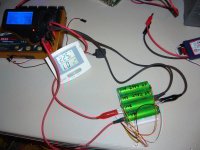Guys,
I'm trying to find more info on exactly what happens when cells are shorted together in parallel. General wisdom on the net says:
-It's ok to discharge cells shorted together in parallel, all chemistries
-It's ok to charge Lithium cells shorted together in parallel
- It's not ok to charge Nimh in parallel.
But that leaves out a lot. What happens if cells are mismatched different capacity? Different internal resistance? How much variance there is in capacity and resistance in different cells?
If I parallel two mismatched cells (say 3Ah and 2.7Ah) what happens to:
- Combined capacity? I suspect I'll get minimum cell capacity (so 2.7 * 2 = 5.4 instead of 5.7Ah) as stronger cell will be dumping its charge to the weaker cell.
- Effect on charge termination/balancing. The weaker pair will be reaching full charge sooner (after 5.4 Ah instead of 6Ah for regular cells). Good balancing circuit should allow those cells to dump charging current while other cells catch up.
More interesting question is what if resistance mismatches? Say my cells are 10 mOhm and 20mOhm. One cell would be getting twice the current of the other cell. Which also means twice the heat. So what are effects on
- Max discharge rating. I guess 2P cells have same C rating as single cell.
- Cycle life. One cell doing way more work than the other cell can't be good
- Cell matching. Harder woking cell would become weaker and weaker, complicating balancing
- Capacity - cell that discharges faster would then be charged by fuller cell, but this is inefficient
- In Nimh this is a runnaway effect as the harder working cell then drops its resistance even more. Do Lithium resistances increase with age? Stay stable?
Any published tests or manufacturer information on this?
Thanks a lot!
I'm trying to find more info on exactly what happens when cells are shorted together in parallel. General wisdom on the net says:
-It's ok to discharge cells shorted together in parallel, all chemistries
-It's ok to charge Lithium cells shorted together in parallel
- It's not ok to charge Nimh in parallel.
But that leaves out a lot. What happens if cells are mismatched different capacity? Different internal resistance? How much variance there is in capacity and resistance in different cells?
If I parallel two mismatched cells (say 3Ah and 2.7Ah) what happens to:
- Combined capacity? I suspect I'll get minimum cell capacity (so 2.7 * 2 = 5.4 instead of 5.7Ah) as stronger cell will be dumping its charge to the weaker cell.
- Effect on charge termination/balancing. The weaker pair will be reaching full charge sooner (after 5.4 Ah instead of 6Ah for regular cells). Good balancing circuit should allow those cells to dump charging current while other cells catch up.
More interesting question is what if resistance mismatches? Say my cells are 10 mOhm and 20mOhm. One cell would be getting twice the current of the other cell. Which also means twice the heat. So what are effects on
- Max discharge rating. I guess 2P cells have same C rating as single cell.
- Cycle life. One cell doing way more work than the other cell can't be good
- Cell matching. Harder woking cell would become weaker and weaker, complicating balancing
- Capacity - cell that discharges faster would then be charged by fuller cell, but this is inefficient
- In Nimh this is a runnaway effect as the harder working cell then drops its resistance even more. Do Lithium resistances increase with age? Stay stable?
Any published tests or manufacturer information on this?
Thanks a lot!




